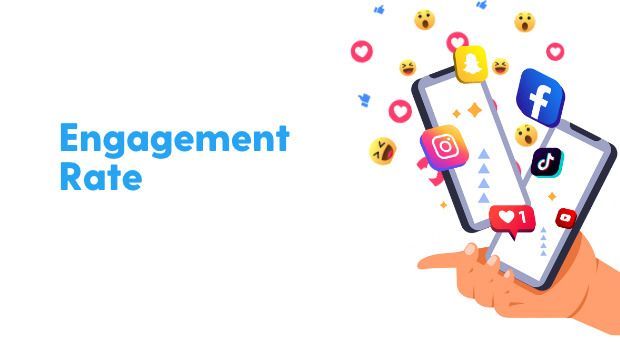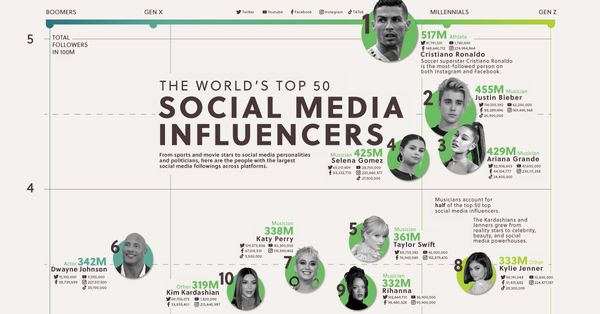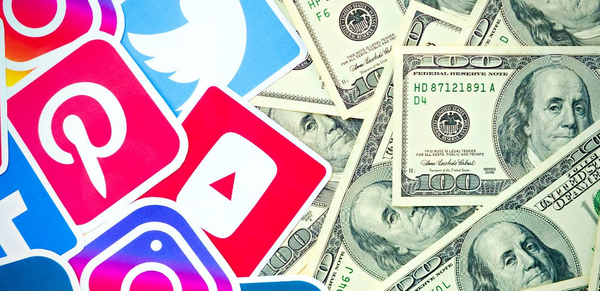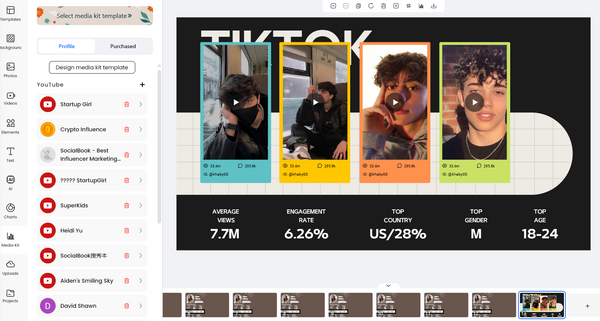In today’s digital landscape, social media has become an integral part of our lives, and it’s easy to see why so many people are fully immersed in this virtual space. After all, who can resist the allure of an ever-evolving digital universe?
In this realm, just as in the physical world, making a significant impact requires investment. While ad spend and promotions are essential, the true measure of success in social media is engagement rate.
To create an effective social media strategy, it’s crucial to focus on the right metrics to foster meaningful connections and interactions with your audience.
In this article, we’ll explore what engagement rate is, why it matters so much, and how to precisely calculate it for each major social media platform.
What Is Engagement Rate?
Let’s delve into what engagement rate really means and why it might not always be as straightforward as it seems. 🫢
Engagement rate is a crucial metric in social media, measuring how actively your audience interacts with the content you publish. In other words, it shows how engaged people are with your posts through likes, comments, shares, saves, and other forms of interaction.
To put it simply, engagement rate gauges how well your content resonates with your audience. A high engagement rate indicates strong connection and interest from your followers, while a low engagement rate suggests that your content might not be hitting the mark, meaning you might need to rethink your strategy.

We’ll explain how to calculate the engagement rate shortly, but before we get into the formula, let’s clarify a few essential points. Engagement rate essentially measures the level of involvement and activity your content generates. It’s calculated by adding up all interactions (likes, comments, shares, saves), dividing that total by your number of followers, and then multiplying by 100. This gives you a percentage that reflects how effectively your content is engaging your audience.
Why Calculating Engagement Rate Matters on Social Media?
When evaluating influencers' performance, brands closely examine various metrics like follower growth, reach, and impressions. However, one metric consistently stands out as a key indicator of true effectiveness: engagement rate.
Evaluating Influencers Using Engagement Rate
When assessing influencers, a high engagement rate is a positive indicator that their audience is actively interacting with their content. This metric, which varies by platform, can signal the potential effectiveness of an influencer in promoting your brand. A high engagement rate often suggests that an influencer’s audience is genuinely interested and may lead to increased brand visibility and potential sales.
However, a low engagement rate can be a red flag, indicating that the influencer's audience might not be fully engaged or interested in their content, which could diminish the benefits for your brand.

Besides engagement rate, there are several other factors to consider when sorting and discovering micro influencers, such as content quality, previous collaborations, authenticity and etc.
Important Caution: Beware of Inflated Engagement Rates
Brands should be cautious, especially with platforms like Instagram, where engagement rates can sometimes be misleading. Some influencers might inflate their numbers by purchasing followers or participating in follow-for-follow schemes, which means their audience might not be genuinely interested in their content. Even if an influencer appears to have a high engagement rate, if their followers are not authentic, collaborating with them could be a waste of resources.
How to Detect Artificially Inflated Engagement Rates?
Here are some steps to identify if an influencer’s engagement rate is skewed:
- Examine Audience Demographics: Check where their followers are based. If a significant portion of their audience is from countries far removed from your target market, this could be a sign of inflated metrics. For instance, if you’re a US-based brand but the majority of the influencer’s followers are from India, their audience may not be relevant to your campaign.
- Identify Fake Followers: Review the profiles of some of their followers to determine their authenticity. Look for signs like profile pictures, a reasonable number of followers, and activity such as posts and captions. If you notice that most followers have no posts, minimal engagement, or appear inactive, this might indicate a fake following. To simplify the process, you can use a reliable platform like SocialBook's SaaS platform. Just enter the influencer’s name, and you'll get all the relevant information you need, saving you time and effort. For example, analysis from the SaaS platform reveals that 84.47% of Katie Brueckner’s followers are real, which is an excellent indicator of authenticity.
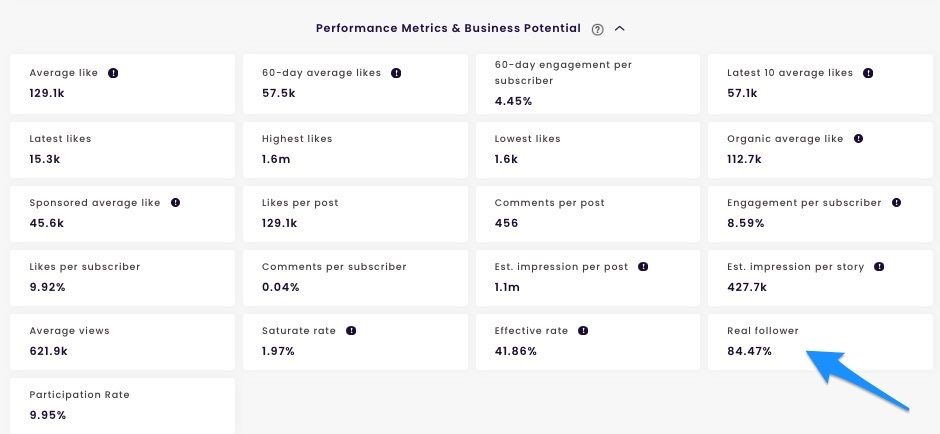
3. Assess Niche Relevance: If an influencer’s followers mostly consist of other influencers rather than potential customers, it could signal a follow-for-follow loop. This setup means that much of their engagement comes from industry peers rather than genuine, interested individuals. Check if their following count is comparable to their follower count, which might also indicate a reciprocal following pattern.
By following these steps, you can better ensure that the influencer you choose has an engaged and relevant audience, maximizing the effectiveness of your collaboration.
How to Calculate Engagement Rate for Different Platforms?
Before we explore how to use this data to optimize your campaigns, let’s quickly review how to calculate engagement rates in influencer marketing.
Engagement can include several types of interactions, typically such as:
- Likes
- Reactions
- Shares
- Comments
- Clicks
- Votes
- Brand mentions
There are different methods to calculate engagement, depending on your campaign goals. One common approach is to divide the total interactions on a post by its reach:
Engagement by Reach = (Total Engagements per Post / Reach per Post) * 100
For example, if a post receives 150 interactions and reaches 750 people, the engagement rate would be (150/750)*100 = 20%. A high percentage like this indicates that the content resonates with a significant portion of the audience.
Another method is to calculate the average engagement rate across multiple posts:
Average Engagement by Reach = (Total Engagements over a Period / Total Posts) * 100
For instance, if a brand posts 15 times in a month and accumulates 3,000 engagements (likes, comments, and shares) during that time, the calculation would be: Average Engagement by Reach = 3000 engagements / 15 posts * 100, resulting in an average engagement rate of 200%.
Both calculations are valid, so you can choose the one that best fits your influencer analytics strategy. The key is to remain consistent and track the same metric over time, allowing you to quickly identify any shifts in engagement rates and assess whether your content is positively or negatively impacting your campaign ROI. What if the statistics are overwhelming and you need to invest a lot of time calculating the engagement rate? Using a tool like SocialBook's SaaS platform might be your best option. For example, to find out ER of Katie Brueckner, simply search her name and wait a few seconds, you'll get the ER info you need.
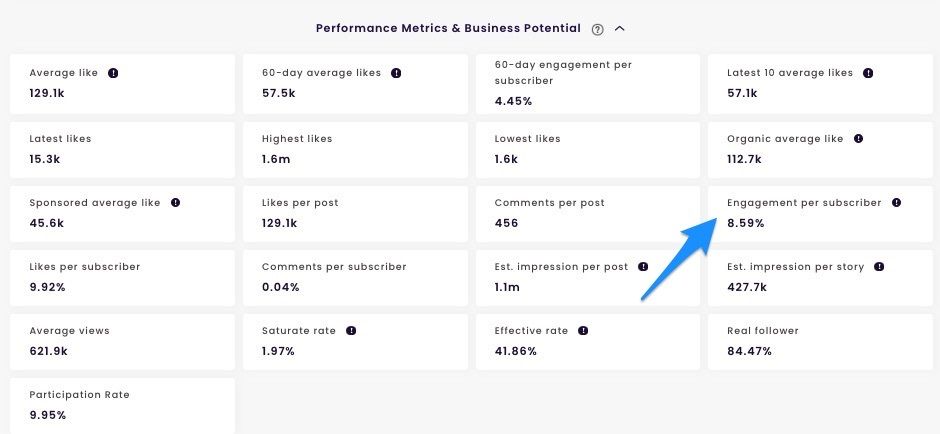
Calculating Engagement Rate on Instagram
Let’s start with Instagram. To calculate your engagement rate, add up all interactions on a specific post (likes, comments, and saves), then divide that number by your total followers and multiply by 100 to get a percentage.
For example, if an Instagram post receives 400 interactions and you have 12,000 followers, your engagement rate would be approximately 3.33%. This method provides a snapshot of how well your audience is responding to your content. Additionally, Instagram Insights offers detailed metrics, such as story views and profile visits, which can enhance your engagement rate calculations. Understanding these metrics helps you tailor your content to better fit audience preferences.
Calculating Engagement Rate on TikTok
For TikTok, calculating your engagement rate involves various user interaction metrics, including likes, comments, shares, and video views.
To compute your TikTok engagement rate, sum all these interactions for a specific period or set of videos. Then divide this total by the number of views and multiply by 100.
For example, if your videos accumulate a total of 800 interactions and 40,000 views, your engagement rate would be 2%. This metric offers insight into how compelling your content is for viewers. Unlike Instagram, TikTok’s algorithm places a strong emphasis on user interactions, making engagement crucial for content visibility. Regularly analyzing these metrics can inform your content strategy and help you create more engaging and shareable videos.
Calculating Engagement Rate on YouTube
On YouTube, the engagement rate calculation includes likes, comments, shares, and the number of subscribers gained from a video.
To determine your engagement rate, sum these interactions for a specific video or over a given timeframe. Then divide this total by the number of views the video(s) received, and multiply by 100 to express it as a percentage. For instance, if a video has 600 interactions and 25,000 views, the engagement rate would be 2.4%.
This rate is essential for understanding audience involvement and the attractiveness of your YouTube content. YouTube Analytics also provides deeper insights, such as average watch time, which helps you gauge engagement beyond surface-level interactions. This information can guide you in creating content that resonates with viewers, encourages interactions, and fosters community engagement.

Final Thoughts
In conclusion, understanding and calculating engagement rates across various social media platforms is vital for any brand looking to enhance its online presence. Engagement rates not only provide insights into how effectively your content resonates with your audience, but they also serve as a key metric when evaluating influencers. By focusing on genuine interactions and being cautious of inflated metrics, you can make informed decisions that drive real results.
As you develop your social media strategy, remember that engagement is more than just a number—it reflects the relationships you build with your audience. Leveraging tools like SocialBook's SaaS platform can streamline the process, allowing you to focus on crafting compelling content that engages and inspires your followers.
Ultimately, a strong engagement rate is indicative of a thriving online community, paving the way for increased brand visibility and potential growth. By prioritizing meaningful connections and continuously refining your approach, you can harness the full power of social media to achieve your business goals. Happy engaging!

